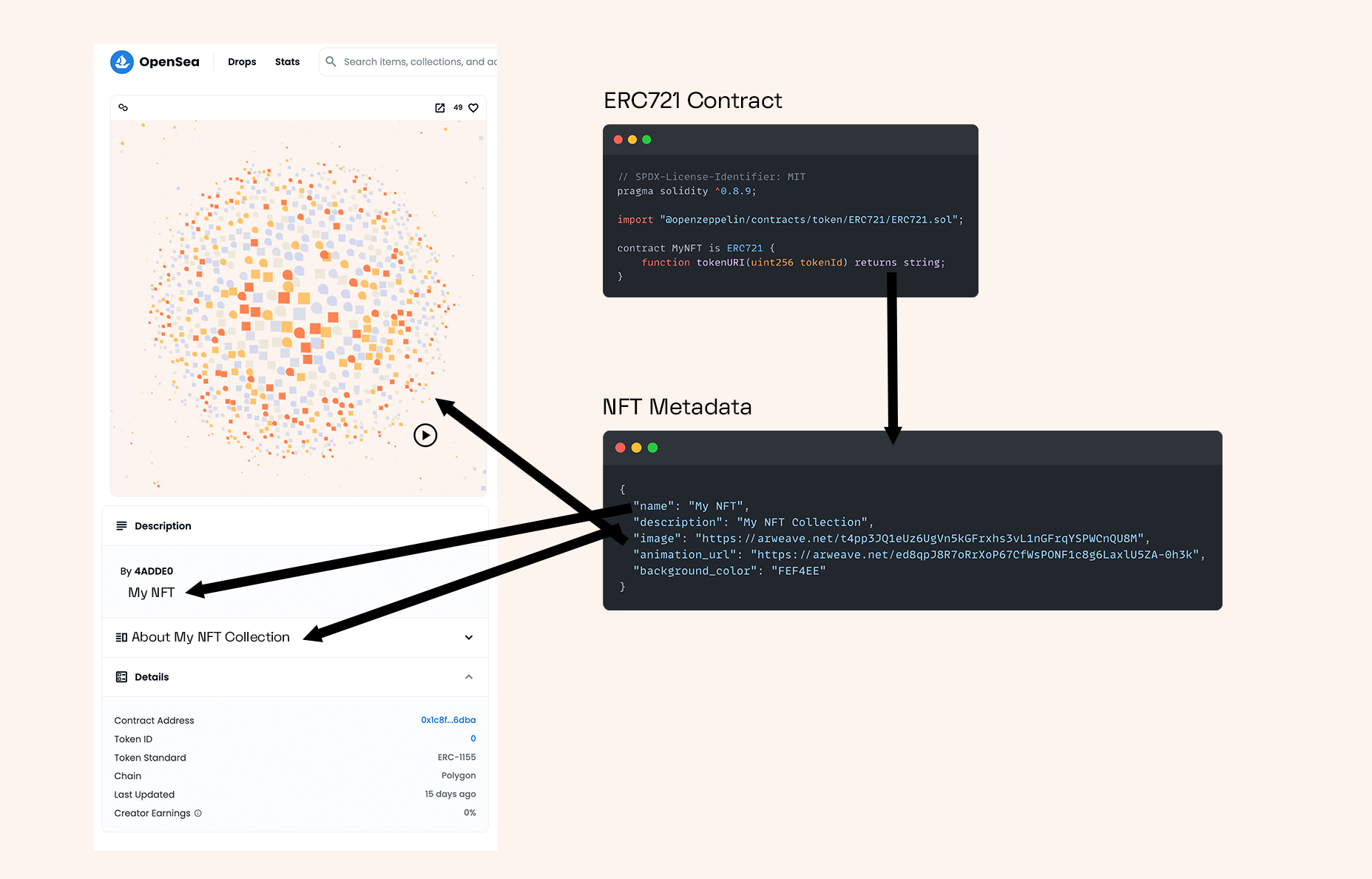Uploading NFTs to Irys
When you use Irys to store NFT assets, you’re guaranteed your NFT will be both permanent and immutable. Here’s how you do it.
NFT Assets

There are three parts to an NFT:
- Smart contract
- NFT metadata
- NFT assets
The smart contract stores a pointer to the NFT metadata, and then the NFT metadata contains links to the NFT assets.
In the example above, there is a name and description that are shown on platforms like Opensea when the NFT is viewed. The image parameter points to a static image of the NFT. You can also add an optional animation_url that points to a video, song, or HTML animation file.
Creating an NFT
Three steps to creating an NFT:
- Upload your assets to Irys.
- Embed the URLs to the assets in NFT metadata.
- Upload metadata to Irys.
- Use the metadata URL to mint your NFT.
Uploading Assets (SDK)
After installing the Irys SDK, upload your assets with:
import Irys from "@irys-network/bundler-client";
import * as fs from "fs";
import dotenv from "dotenv";
dotenv.config();
const uploadImage = async () => {
const irys = await getIrys();
const fileToUpload = "./myNFT.png";
// Get size of file
const { size } = await fs.promises.stat(fileToUpload);
// Get cost to upload "size" bytes
const price = await irys.getPrice(size);
console.log(`Uploading ${size} bytes costs ${irys.utils.fromAtomic(price)} ${token}`);
await irys.fund(price);
// Upload metadata
try {
const response = await irys.uploadFile(fileToUpload);
console.log(`File uploaded ==> https://gateway.irys.xyz/${response.id}`);
} catch (e) {
console.log("Error uploading file ", e);
}
};Uploading Assets (CLI)
Alternatively, you can upload using our Storage CLI.
irys upload myNFT.png \
-n testnet \
-t ethereum \
-w bf20......c9885307 \
--tags Content-Type image/png \
--provider-url https://rpc.sepolia.devCreating Metadata
Embed the URLs generated from the above into your NFT metadata.
{
"name": "My NFT",
"symbol": "MNFT",
"description": "To the moooooonnnn",
"image": "https://gateway.irys.xyz/737m0bA1kW4BlIJOg_kOGUpHAAI-3Ec9bdo8S_xTFKI",
}Uploading Metadata (SDK)
Finally, upload your NFT metadata to Irys and use the URL generated to mint the NFT.
import Irys from "@irys-network/bundler-client";
import * as fs from "fs";
import dotenv from "dotenv";
dotenv.config();
const uploadMetadata = async () => {
const irys = await getIrys();
const fileToUpload = "./metadata.json";
const tags = [{ name: "Content-Type", value: "application/json" }];
// Get size of file
const { size } = await fs.promises.stat(fileToUpload);
// Get cost to upload "size" bytes
const price = await irys.getPrice(size);
console.log(`Uploading ${size} bytes costs ${irys.utils.fromAtomic(price)} ${token}`);
await irys.fund(price);
// Upload metadata
try {
const response = await irys.uploadFile(fileToUpload, { tags: tags });
console.log(`File uploaded ==> https://gateway.irys.xyz/${response.id}`);
} catch (e) {
console.log("Error uploading file ", e);
}
};Uploading Metadata (CLI)
Alternatively, you can upload using our Storage CLI.
irys upload metadata.json \
-n testnet \
-t ethereum \
-w bf20......c9885307 \
--tags Content-Type application/json \
--provider-url https://rpc.sepolia.dev